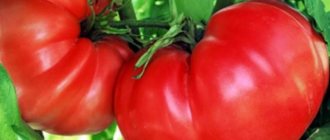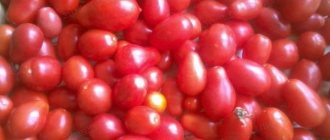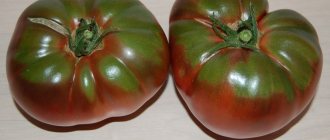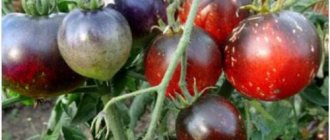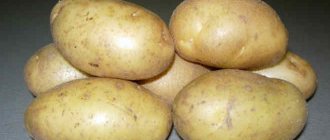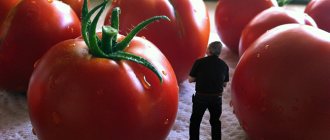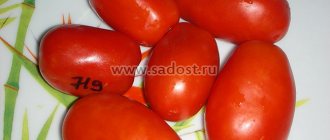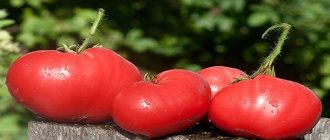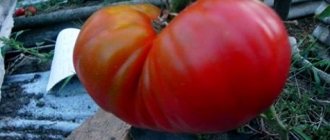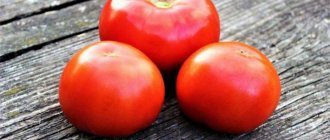Red large is considered the leader in the list of large-fruited tomato varieties. The cultivar is valued for its stable productivity, giant fruits of a presentable appearance with excellent taste. Bonuses include strong immunity, endurance and adaptive capabilities.
| Height | Landing location | Ripening time | Fruit color | Fruit size | Origin | Fruit shape |
| Medium height | Greenhouse, Open ground | Mid-season | Reds | Large | Variety | Flat-round |
Features of choosing a tomato variety
Tomato varieties are divided into those that are planned to be consumed fresh, and those that are grown for long-term storage. To avoid making a mistake in your choice, follow these rules:
- Early bush or standard hybrids are suitable for open soil.
- The speed of crop ripening does not matter if the plants are planted in a well-equipped greenhouse - the height of the bushes and the nutritional characteristics of the selected species are more important.
- On the seed package you need to find the region for which this variety is suitable.
- The most unpretentious, small-fruited and determinate - they will suit those who do not have the opportunity to devote a lot of time to care.
- To prepare tomato juice, tomatoes with thin skin are used, and types with thick skin are used for preservation.
- Tomatoes with a rich taste are used for salads.
The best varieties of tomatoes for the Moscow region and the middle zone
The climate of the central regions (Moscow, Ryazan, Vladimir, Smolensk, Yaroslavl, Kostroma, Ivanovo regions) is characterized by warm and humid summers, which are replaced by snowy winters. The air temperature in the summer season is favorable for both greenhouse planting and outdoor propagation.
For glass and polycarbonate greenhouses
In closed ground, the yield depends on the microclimate, which is easy to maintain throughout the year. In central Russia, the following varieties are most in demand for greenhouses.
De barao
A variety suitable for preparation and use in salads. Tomatoes ripen 4 months after the first shoots appear. Each bush brings 3-4 kg of harvest.
Tall. The fruits are oval, of different colors from pinkish to black. They have excellent taste and are suitable for long-term storage.
Blagovest
An early-ripening universal hybrid that requires regular fertilizers and garter. It grows up to 1.8 m, the fruits ripen in 100 days.
The harvest is abundant and large-fruited.
Bull's heart
One of the largest varieties of tomatoes. It bears heavy and juicy heart-shaped fruits, the weight of which can reach 300 grams.
Unpretentious, suitable for beginner gardeners. The period from germination to ripening is 107 days.
Pink honey
Indeterminate mid-early greenhouse species with average resistance to diseases.
Large heart-shaped tomatoes on the lower branches weigh up to 600 grams, have a fleshy structure and a sweetish taste. Not intended for canning, good for salads.
Eagle beak
A universal variety that bears up to 8 kg of red pointed fruits from one bush. Resistant to diseases.
With careful care, outdoor cultivation is possible.
Alenka
The harvest ripens in three months. The bushes are small, up to 60 cm. Plants rarely get sick; strong stems bear fruit without garters.
The tomatoes are round and small, pink, with juicy sweet flesh.
Cardinal
A large-fruited plant, it is characterized by increased fruiting and produces sweetish pink-raspberry fruits with a rich taste, suitable for making juice and fresh consumption.
Cold-resistant and disease-resistant.
Irishka
A hybrid that delights gardeners with delicious scarlet tomatoes that ripen in 80-90 days.
Easy to care for, but does not tolerate low temperatures and requires preventive measures against late blight.
Wonder of the earth
Bred by an amateur gardener, this variety is characterized by large and tasty tomatoes, in some cases weighing up to 1 kg.
There are often fakes on the market, so to obtain a high-quality harvest, seeds are purchased from reliable retail outlets. The humidity in the greenhouse when growing it should not exceed 60%. Every 10 days, stepsoning is carried out.
Andromeda
A low-growing, early-ripening hybrid that produces up to 10 kg of yield per plant.
Requires picking and regular moistening of the soil.
For open ground
In greenhouse conditions, tomatoes ripen faster and produce a richer harvest. But there are reasons why gardeners choose open ground:
- Lack of a greenhouse on site.
- Preference for varieties that are not intended for greenhouse cultivation.
- Lack of regular watering and maintenance.
In the climate of the Moscow region, these types of tomatoes take root best.
White filling
This variety was bred in Kazakhstan in 1979 and is in demand among summer residents in Russia and the CIS. When planted in open soil, the bushes are low, up to half a meter.
They can easily withstand cold spells. Harvesting is carried out 100 days after the sprouts are received.
Sultan
A Dutch variety of tomatoes that has taken root well in the central and southern regions of Russia.
Low miniature bushes with dark green leaves bear up to 7 medium red tomatoes.
Tamara
Early-ripening dense tomatoes ripening on low bushes.
They require careful care and require frequent watering. Before planting, the soil is soaked with organic fertilizers.
Explosion
A new hybrid characterized by high nutritional value and rich vitamin composition. In open ground it grows better in southern latitudes, but you can also get a harvest in gardening in the central regions.
To keep the plants healthy and large, before planting, the seeds are soaked for 6-10 hours in aloe juice. The seedlings are prepared in April and transplanted into the beds at the end of May.
Otradny
A miniature and unpretentious species, the height of which does not exceed 45 cm. Does not require gartering and is not susceptible to rot.
Red, small, sweet and sour tomatoes ripen in 95 days. Suitable for canning and fresh consumption.
Fitous
Phytous is an abbreviation for the word blight-resistant. It is highly resistant to late blight and other diseases.
Planting takes place in early April. The fruits are small, with thick skin, ideal for harvesting.
Demidov
Pink, round tomatoes that ripen in 107 days. This species is intended only for planting in open ground.
It is not demanding in care, but insufficient watering can lead to blossom end rot.
Sanka
A popular low-growing tomato characterized by rapid ripening. The first ripe tomato can appear on the branches within 65 days after planting in the ground.
Small, sweet and sour fruits are excellent for preparations.
Olya
A relatively young hybrid variety that has gained popularity among gardeners in Central Russia.
Unpretentious, does not require pinching, tolerates low light and cool summers. Suitable for fresh consumption, as well as for preservation.
Japanese black truffle
A determinate, medium-growing hybrid that produces unusual pear-shaped tomatoes of a dark brown or burgundy color.
Resistant to rot and not susceptible to insect pests. The ripening period is 3 months.
Leningrad chill
Low variety (up to 35 cm), bred specifically for planting in open soil. Able to withstand severe temperature changes, resistant to cold.
During the flowering period, it requires fertilizing with magnesium and potassium sulfate. If you follow the care recommendations, it produces up to 3 kg of yield from one bush.
Barnaul Cannery
Low-growing, early-ripening variety, producing round, red-orange tomatoes.
Designed specifically for salting and preparing for the winter.
Snowdrop
An early ripening, unpretentious tomato, suitable for planting in poor soil. In the southern regions it grows poorly, but in cool summer conditions the fruiting is abundant.
In greenhouse conditions it can grow even in the Far North.
Mirage
Low-growing bushes bearing red oval tomatoes.
Suitable for both fresh consumption and canned food.
Description and characteristics of the variety
The large Red tomato brings the first harvests within 110-120 days. The variety is a mid-season semi-determinant. It is cultivated universally in open areas and in protected greenhouse structures.
The originator of the variety in Russia is the breeding plant, whose line includes interesting large varieties.
What you should know about the variety:
- mid-ripening;
- shoot height 1-1.5 m;
- large fruit;
- simple inflorescences;
- semi-spreading strong bushes.
Fruiting lasts a long time - from July until the first autumn frosts. Tomatoes keep well for 3-4 weeks. When fertilizers are applied in a timely manner, the variety reacts responsively (the yield increases).
Description of tomatoes:
- average weight 500-600 g;
- flattened, round shape;
- coloring is saturated;
- the pulp is fleshy, moderately juicy (important for juices);
- classic sweet and sour taste;
- The skin is strong and does not crack.
Large tomatoes are cut into fresh dishes, juices and sauces, dressings and ketchups are prepared in the Italian style (spicy and aromatic).
The best varieties of tomatoes for the Urals
The climate of the Middle and Southern Urals is moderate, with warm, sunny summers, but the soil does not have a variety of mineral composition. In the Northern and Subpolar Urals the impact of subarctic winds is already being felt. During the cold season, the ground freezes very much, so southern varieties of tomatoes do not take root or produce a meager harvest. Tomatoes of Siberian selection are suitable for the Urals.
Features of choice
The Ural climate is varied, so to obtain juicy tomatoes, the variety is chosen in accordance with the weather conditions of the region. The best species are those that do not require painstaking care, do not freeze when the temperature drops, and ripen quickly during the short summer.
For the greenhouse
Although plantings in a greenhouse are not as noticeably affected by temperature changes as those growing in the open air, they are just as sensitive to weather changes. Therefore, unpretentious tomatoes with strong ovaries and immunity to diseases are selected for Ural greenhouses. The most productive varieties grown by gardeners in the Urals are as follows.
Lelya
One plant gives the owner up to 4.5 kg of tomatoes.
An early ripening variety, it rarely gets sick and easily tolerates cold.
Bersola
Large-fruited hybrid species, characterized by rapid ripening.
Kohawa
Unpretentious, brings a rich harvest of large pinkish fruits.
The yield is quite high, disease-resistant.
Titanic
A mid-season hybrid, distinguished by tomatoes weighing up to 200 grams with a pleasant sweet taste.
Rarely gets sick.
Kostroma
One of the most favorite varieties of gardeners in the Urals. It rarely gets sick, each bush produces up to 4.5 kg of harvest.
Resistant to parasites.
Wonderful lady
These high-yielding tomatoes are highly resistant to disease, cold and pests.
They are classified as early ripening. Stress-resistant.
For open ground
If you plan to grow tomatoes outside, they are pre-hardened off at the seedling stage. To do this, place containers with seedlings in fresh air and leave for 10-15 minutes. You cannot keep the sprouts in the cold - they can freeze and die.
Outdoor tomatoes for the Ural region should be characterized by increased early ripening. These types are suitable.
Alsou
This variety produces juicy and fleshy tomatoes, but its yield is low.
Siberian early ripening
It bears fruit better in a greenhouse, but can also grow outdoors.
Siberian Express
The advantage of this species is its small size, due to which the plants do not require staking.
Well kept.
Gina
Another dwarf variety that bears large and tasty fruits.
Robinson F1
Ural variety with large raspberry tomatoes.
Growing and care
For planting, select a fertile area in the sun. Good predecessors are:
- pumpkin and cucumber crops;
- onion and garlic;
- cabbage;
- carrots and beets.
When planting, add the Red Giant fertilizer of the same name or a mixture of 10/8/8 (nitrogen, phosphorus, potassium) to the holes when planting.
The holes are made at a distance of 50-60 cm, they dig up to 20 cm deep. The bushes are placed freely and sprinkled with earth.
Agronomists advise keeping bushes in 2 trunks and carrying out regular pinching.
Features of care:
- They are fed with organic matter and minerals (fertilizers are applied once every 12-15 days, root and foliar methods are used).
- When flowering, preference is given to compositions with a reduced level of nitrogen, but containing phosphorus and potassium (ideal proportions 5/10/10).
- Water regularly, moderately (to avoid souring of the beds). The frequency of the procedure is 2-4 times a week. The fluid requirement is from 1 to 4 liters. for 1 bush.
- Add organic mulch to prevent drying out, protect against pathogens and temperature changes.
The best varieties of tomatoes for Siberia
Temperature changes in Siberia are particularly pronounced. Summer is short, the air is hot and dry during the day, and frost sometimes occurs at night. Stress-tolerant tomatoes, which mainly include new varieties of hybrids, are taking root in this region.
Summer residents of Western Siberia prefer varieties such as Alsou or Siberian early ripening, while in the east Siberian Express and Gina are popular. But there are other varieties that are suitable for Siberian gardens.
For the greenhouse
There are varieties designed specifically for greenhouses in Siberia.
Altai strongman
Unusual fruits with a distinct taste.
Universal, used for preparations and salads.
Greek
Tall bushes producing fleshy raspberry tomatoes with thin skin.
Early ripening, excellent taste and long-lasting presentation.
Scarlet Mustang
Elongated, original fruits.
With regular feeding and proper care, one plant brings 5 kg of harvest.
Your Majesty
Very tall tomatoes that require garter.
Large, yellow, heart-shaped tomatoes that can weigh up to 1.5 kg. Salad variety.
For open ground
In Siberian territories, those varieties that are not picky about the composition of the soil and do not lose their ovaries during cold weather take root.
Abakan pink
Bred in Altai, perfectly adapted to the climate of Eastern Siberia.
Large ribbed fruits delight gardeners with their fleshy pulp and pleasant taste.
Chinese heat resistant
An early ripening variety, resistant to the heat typical of July in Khakassia and the Krasnoyarsk Territory, but at the same time adapted to the climate of Siberia.
Pinkish tomatoes are suitable for pickling.
Canopus
An unpretentious large-fruited species, the advantage of which is late blight resistance.
Yamal Early ripening
A large-fruited variety that can survive in the Far North.
King of Siberia
Giant tomatoes with thin skin, weighing up to 1 kg.
Due to the heaviness of the fruits, the bushes require staking and careful care.
What varieties of tomatoes for greenhouses do experienced summer residents buy?
What varieties of tomatoes for greenhouses do residents of the middle zone prefer?
If you are a beginner summer resident, and this is your first year installing a greenhouse, then be sure to listen to what your neighbors in the area will tell you. Residents of the middle zone (the region of the Smolensk region and the nearest Moscow region) prefer to use these varieties: Russian Domes, Giant, Arbuzny, Northern Beauty, Lion's Heart and Kaspar. This is a red tomato, and among varieties of other colors, Pepper Yellow bears fruit well. Residents of the northern regions (Leningrad, Vologda and Pskov regions) can always count on Northern Beauty and Seva seed.
Early varieties of tomatoes for greenhouses
If you want to get your first tomatoes a couple of weeks earlier than your competitors in your summer cottage, then take a closer look at the varieties Blagovest, Yarilo, Gina, Scorpion and Funtik. These hybrids, with sufficient lighting and proper feeding, sometimes ripen 20 days earlier than the rest of the tomatoes.
The best varieties of tomatoes for greenhouses with contaminated soil
Late blight is still a nuisance. Sometimes you can’t get rid of it within a few years. What should those who cannot move the greenhouse to another place do? Do not despair, because breeders have developed varieties of tomatoes that are not afraid of late blight. Buy Budenovka, Blagovest, Erema, Intuition or Evpator and feel free to plant them in a greenhouse, having previously treated the soil against misfortune. The last 4 varieties must have the prefix F1 on the label.
Wet soil
What to do with a wetland? While you are struggling with excess moisture in the dacha and carrying out drainage work, ask one of your family members to buy Yablonka, Mithridat, Pharaoh, Ofenya or Dobrun tomatoes in a specialized store. These tomatoes are not afraid of excess moisture, so they will grow and bear fruit just like their brothers in dry soil.
What varieties of tomatoes should be planted under glass for greenhouses?
Not all hybrids grow under film, some of them can only be grown under glass, for example, Kirzhach, Bel Canto, and varieties such as Krasnobay and Tuymazinets prefer polyethylene. Still, most tomatoes feel great under any cover.
Excellent varieties of tomatoes for greenhouses and home canning
If you want to please your family members and guests with excellent tomatoes that you won’t be ashamed to serve on the table or use for dinner, try growing the Black Prince, the Pink Giant and the hybrids Sultan, Rosemary, Miracle of the Market, and Druzhok. The small fruits are a little sour, but you won’t find better varieties for tomatoes in their own juice. They are not afraid of high temperatures, do not crack and do not turn into crumbs when sent to boiling brine.
Yield varieties of tomatoes for greenhouses in the northern regions
If your dacha is located in the area of the conventional Polotsk-Pskov strip, then take a closer look at varieties such as Olya, Verlioka, Ural and De Barao. These tomatoes can survive in conditions of cold nights, light frosts on the soil and 12 hours of daylight. Despite the fact that low temperatures are not terrible for the above tomatoes, they also bear fruit well. From 100 bushes you can collect at least 30 ten-liter buckets of fruit, the size of a child’s palm.
syl.ru
The best varieties of tomatoes for Belarus
Belarusian gardeners prefer to grow greenhouse species, since the country's summers are cool and short. But today in stores you can find seeds suitable for open ground.
As in Russian regions, when choosing a variety, Belarusian summer residents are guided by the tomato’s unpretentiousness, resistance to cold and ability to ripen quickly.
For greenhouses
Many varieties take root well in Belarusian greenhouses, but the following varieties have the best yield.
Start
Tall, early ripening plants bearing sweet and dense fruits.
Early-83
In demand among gardeners in Belarus and Central Russia.
Medium-fruited, ripens in 95 days.
Baby F1
An unpretentious hybrid that is suitable for beginner gardeners.
It is not affected by microorganisms, but bears fruit successfully only in greenhouses.
Verlioka F1
Another hybrid variety that is bred for greenhouses with low light levels.
Red Arrow
Brings a rich harvest of large and juicy fruits, universal in use.
For open ground
Varieties adapted to temperate climates and short summers are grown in outdoor garden beds. The most commonly chosen types are:
Morning
A determinate, low-growing shrub characterized by lush greenery.
Does not require complex care, is not picky about the soil, but requires pinching.
Peremoga
Achievement of Belarusian selection.
Low plants bring their owners up to 5 kg of juicy tomatoes.
Ruzha
Designed specifically for the climate of Belarus.
Small, neat tomatoes have a great taste and are high in vitamin C.
Profitable
An early ripening universal variety that is suitable for beginning gardeners.
It is not demanding in terms of care, but requires mineral supplementation.
My problem-free tomatoes. 10 early varieties of tomatoes without pinching
Choosing a variety today is a difficult task for a gardener. You need to try to choose a variety that is suitable for care, quality and yield.
I would like to plant seedlings in March so as not to bother with lighting in February.
Then I would like to plant good seedlings in open ground or a film greenhouse and in June-July begin to feast on delicious fruits, without particularly bothering to care for the planted bushes.
Of course, that’s what I want too. :)) That’s why every year I try early-ripening determinate varieties of tomatoes for open ground. This year I planted 10 varieties.
I planted five of them last year and I was pleased with the results. Now I have added five more new varieties to these varieties.
These are all determinate varieties, the yield is average and higher (6 kg per 1 m2), not capricious when grown, does not require pinching
.
Of course, determinate (with limited growth, low-growing) varieties are inferior in yield to indeterminate (tall) varieties. But the main advantage of low tomatoes, in my opinion, is their low maintenance requirements.
So to speak, “dropped it and forgot it.” You only need to water as needed and fertilize a couple of times a season (during flowering and fruiting).
With tall ones, it’s more difficult - constant stepsoning and shaping - sometimes there’s simply not enough time for this.
Moreover, it is too late to sow indeterminate varieties for seedlings and I wrote WHAT I can do with them to increase productivity in one of my previous articles.
Today it's time to talk about determinants. It’s time to sow them as seedlings, and some can be planted with seeds in April directly into the ground.
Tomato Golden Eggs
Plant height is about half a meter, compact, determinate, early ripening variety. The plant is resistant to sudden temperature changes. Fruits of universal use, average weight 200 g. Productivity 8–10 kg/m2. Placement per 1 m2 4–5 pcs.
Tomato Salted
Early ripening, large-fruited, determinate variety. The height of the bush is 70–80 cm, spreading. Resistant to temperature changes. The fruits are flat-round, fleshy, weighing 350–600 g. universal purpose. Placement: 3–4 plants per 1m2.
Tomato Amber 530
Early ripening, suitable for growing without seedlings. The plant is determinate, compact, 30–40 cm high. Fruits weigh 50–90 g. Resistant to a number of diseases and temperature changes. Placement per 1 m2 4–5 pcs.
Tomato Parsley gardener
The variety is mid-early, 50–60 cm high, determinate. The fruits are elongated, oval in shape, weighing up to 200 g. universal purpose. Productivity – 4–6 kg per 1 m2. Placement of up to 5 plants per 1 m2.
Tomato Nepas 5
Mid-early (100–105 days), standard plant, 50–60 cm high. Fruits of original color, universal purpose, weighing 60–80 g, dense, well stored. Placement of up to 5 plants per 1 m2.
Tomato Boni MM
Ultra-early ripening (80–85 days), low-growing (40–50 cm), determinate variety, produces the entire harvest in 2 weeks. The fruits are flat round in shape, weighing 60–70 g. The yield of one plant is 2.0 kg. When planting seedlings in May, fruiting begins at the end of June. Seeds can be sown in April directly into the ground under a film cover. Placement per 1 m2 4–5 pcs.
7 Tomato F1 Cherryfingers
Early maturing carpal hybrid. The plant is determinate, compact, 50–60 cm high. The fruits are elongated, cylindrical, weighing 35–45 g. Suitable for whole fruit canning and processing. The hybrid is characterized by friendly maturation. Planting pattern 50x60 cm.
Tomato Shchelkovsky early
Extra Early determinate variety, compact bush 30–35 cm. Fruits of universal use, weighing 40–60 g. Fast and friendly yield, suitable for direct sowing of seeds in the ground and thickened plantings.
Tomato Super-klusha
Mid-early (100–105 days), low-growing (30–40 cm), determinate variety. The fruits are round, weighing 150–200 g. Productivity up to 10 kg per 1 m2. Placement 4 pieces per 1 m2.
The best varieties of tomatoes for the Vitebsk region
The Vitebsk region has a short, rainy summer, so little time is allocated for the harvest to ripen. Vitebsk gardeners choose varieties adapted to cool temperatures and ripening quickly. All tomatoes are grown using the seedling method.
Climate Features
The weather conditions of the Vitebsk region are influenced by Atlantic air masses. The climate is temperate and humid. Frosts are common in spring, and summers are relatively cold. In this climatic zone, tomatoes are more susceptible to diseases; southern varieties are often affected by rot. Greenhouse hybrid varieties take root better.
For greenhouses
The most popular are two varieties.
Appetizing and Irish liqueur
They belong to mid-season varieties (the harvest is harvested in 115-120 days), and do not take root well in open ground.
Standard care is required, including mandatory staking, since the plants grow tall, with a large number of ovaries. The appetizing variety produces large dark red fruits with a black tint. Irish liqueur remains green-yellow when ripe.
For open ground
Low-growing, dwarf plants are suitable for outdoor growing.
Volgograd early ripening
It does not suffer from late blight, the ripening speed corresponds to the name - the tomatoes are ready for consumption 95 days after planting the seedlings.
Openwork F1
Although this hybrid is a mid-season hybrid, it takes root well outdoors, is not susceptible to diseases and is characterized by rich yields.
Cream
Neat, compact plants that delight their owners with dense, sour fruits.
Tomatoes for the Leningrad region
The main criterion when choosing tomatoes for the Leningrad region and Karelia is frost resistance. In a polycarbonate greenhouse, the following species will produce a bountiful harvest.
Alcazar
Indeterminate hybrid, suitable for planting in mineral-poor soil.
Taimyr
Frost-resistant hybrid variety that is immune to powdery mildew.
Cunero
One bush will yield 4-6 tomatoes with smooth glossy skin and a pleasant taste.
Rhapsody
It takes root well in poor northern soil, while producing juicy fruits.
The best varieties for the Saratov region
The Saratov region is characterized by strong temperature changes, when a hot summer day gives way to cold nights. Such varieties tolerate such conditions best.
Iron Lady F1
An unpretentious hybrid species intended for planting in closed ground.
Kolkhozny
It takes root well in Saratov areas and has sweet, loose flesh.
